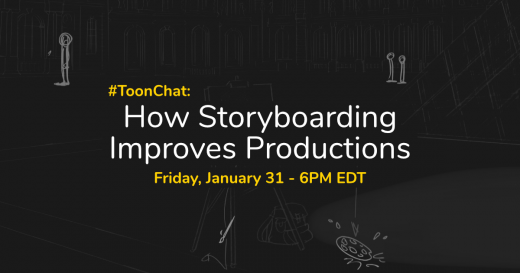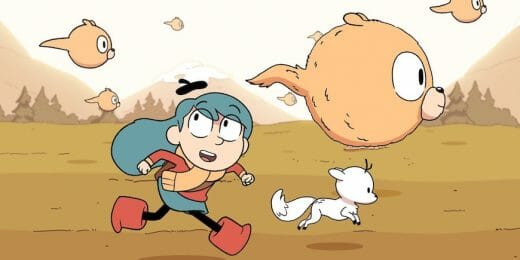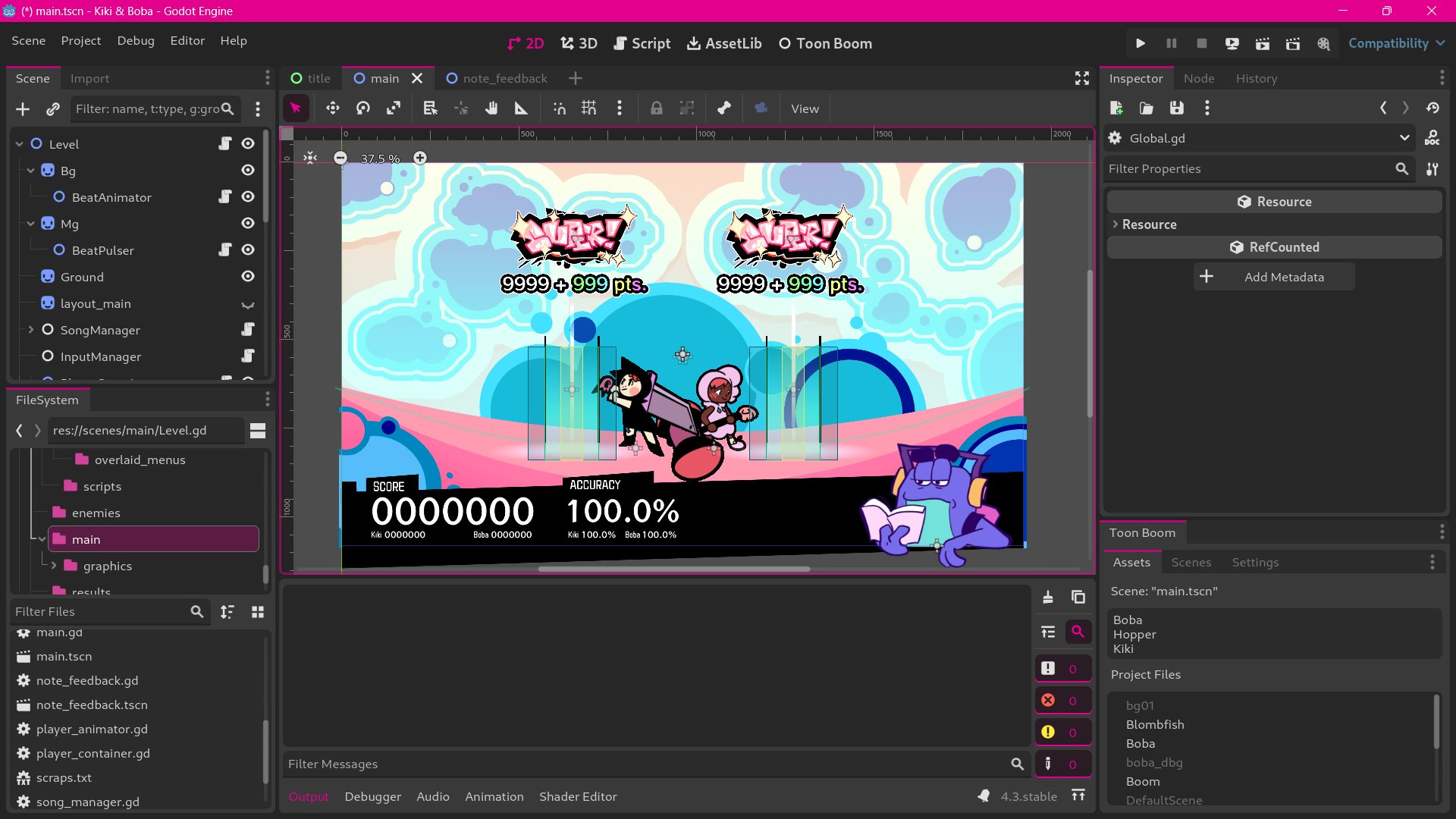
When Landon X. Jenkins, Finn Kulers, and Vincent Tracy teamed up for Toon Boom’s Winter Game Jam, they had just twelve days to prototype a playable game inspired by a theme: Boom! The result was Kiki & Boba, a rhythm game featuring two stylized characters defeating enemies in sync with the beat.
Drawing from their sketchbooks as well as their mutual love of rhythm games, these three artists combined their passions for illustration, animation, and games with Toon Boom Jump! (currently in public beta), to create a polished and satisfying prototype. Their hard work was rewarded, as Landon, Finn and Vincent won first place.
Read on to learn Landon, Finn, and Vincent’s insights about their creative process during the game jam, the challenges they faced in designing Kiki & Boba, and what might be coming next from their collaboration.
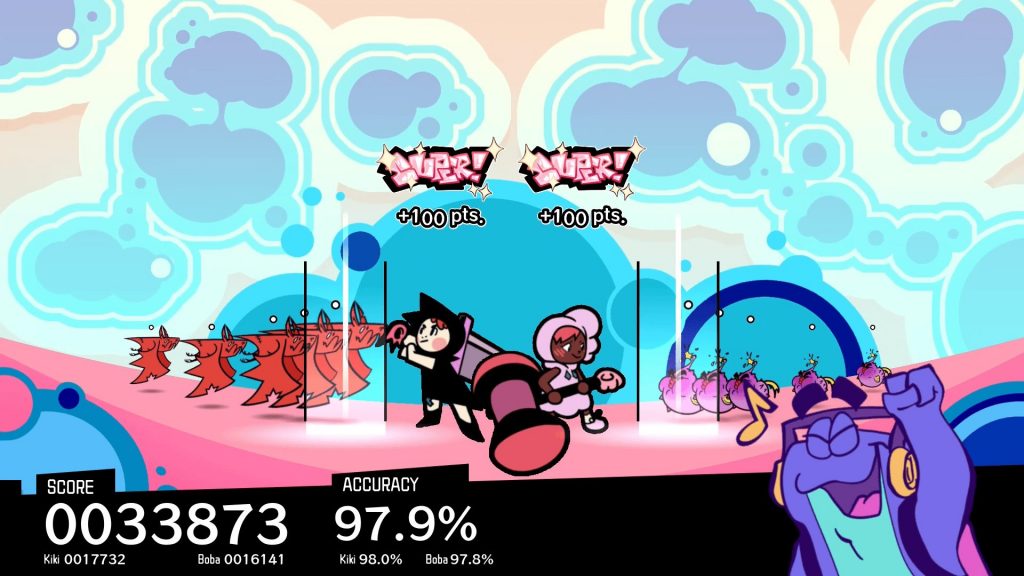
Could you share a bit about your animation backgrounds?
Landon: Growing up, I loved animation, video games, and computers. My mom had a treasure trove of early-2000s design software from her graphic design days, so I eagerly played with Flash, Fireworks, AppleWorks and more. When I was 9, I made my first game, “PhunnyButtons”. Throughout the next several years, I continued to draw, animate, and develop small games using other software, like Unity.
Later, I went to Savannah College of Art and Design in Atlanta, where I majored in animation. Since then, I’ve jumped into freelance as a 2D generalist, with a focus on designing and developing memorable characters.
Vincent: I’m actually an illustrator, not an animator, but I joined the animation crowd at Savannah College, where I majored in assets for animation games. I’ve been drawing since I was very young.
I was that kid in middle school who drew on people’s hands. Everyone was like, ‘You should be a tattoo artist!’ That made me wonder if I could draw professionally. I’m aiming to be a professional illustrator, but I love working in the animation world.
Finn: Watching cartoons growing up was super transformational for me. I wanted to create something that inspired others the same way these pieces of art had inspired me.
I love games, and I love the charm that 2D animated games have. I’m really dedicated to satisfying motion and complete arcs and getting into the technical side of animation, but lately I’ve been more into character design.
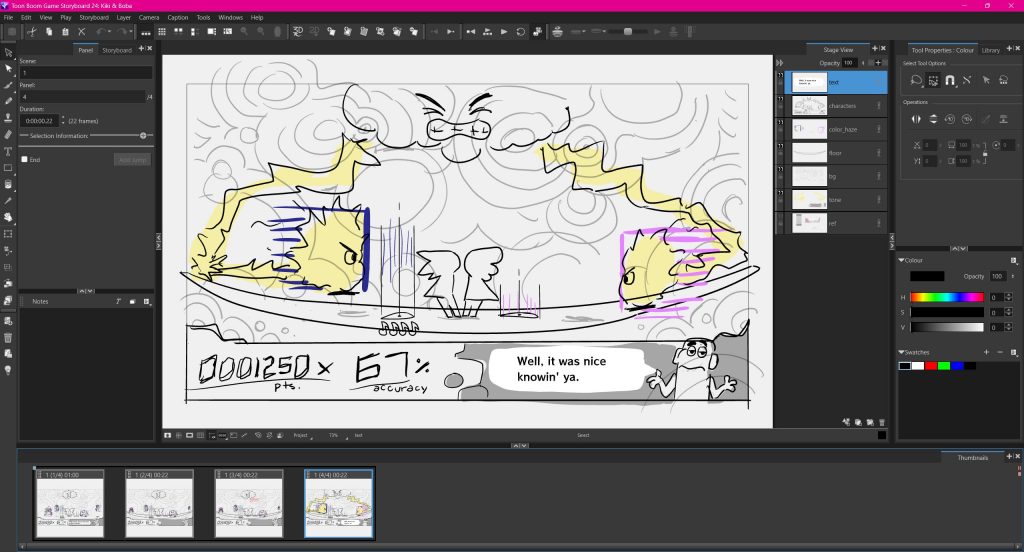
How do you all know each other? How did you come together as a team to work on Kiki & Boba?
Finn: Landon and I met in one of our early animation classes and we worked on a short together called Outta Here. It was about an alien so fed up with their home planet that they leave, only to realize there is nothing to do in space.
I met Vincent through a mutual friend of ours and we became roommates. Landon mentioned that he was working on a game for Toon Boom’s game jam and asked me if I was interested. I was, and I right away suggested that Vincent could be a great addition to the team. That’s how we all came together to work on Kiki & Boba.
You built the game as part of Toon Boom’s Winter Game Jam. How did you find out about the game jam, what made you interested in doing it?
Landon: I first heard about Jump! last year when I was in the Toon Boom Ambassador Program. After the Discord server opened for beta testers, I was excited to give it a try. It was great timing; with Flash going the way of the dodo, I’d been wishing for a quicker, easier way to make 2D-animated games, and I already knew Godot Engine [which is also integrated in Jump!].
I felt the game jam would be a great opportunity to test out the game engine integration, and I’d been itching to make another small, complete project.
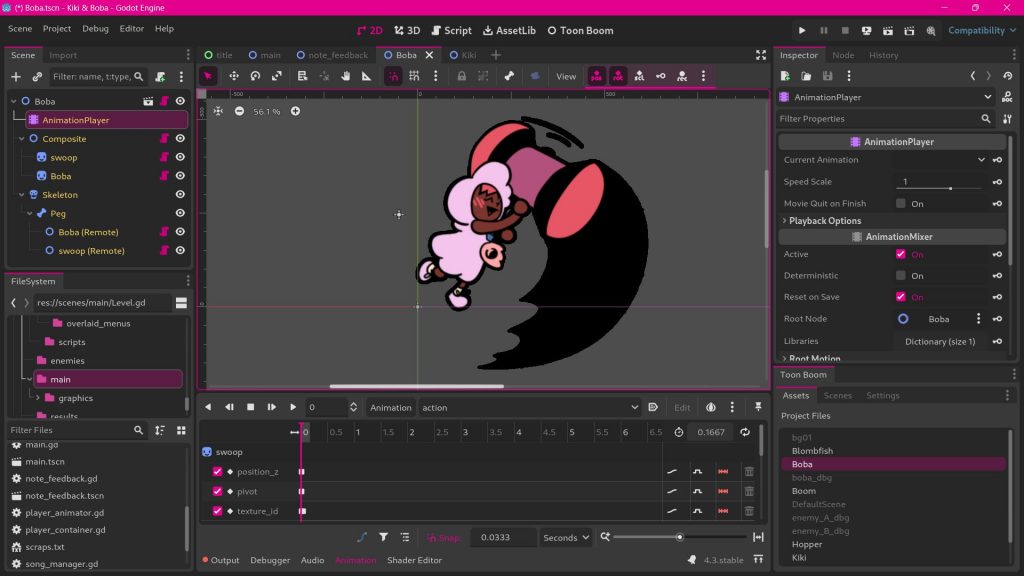
Tell me about your game, Kiki & Boba! What type of game is it, and how does it work?
Landon: Kiki & Boba is a rhythm game! The object of the game is to defeat enemies that are synced to the music. As you play, you use keyboard commands to take out incoming attackers, and your commands are timed to the music.
Your score in the game is based on how good your timing is, and at the end of the game, you’re ranked based on your accuracy. If you’re really consistent, you can get the highest rank, which is called a Ka-Boom! We’re thinking of adding on different features to the game as well, like new types of enemies, new songs, and even swapping Kiki & Boba’s places for an extra challenge.
What inspired the concept for the game? How did you decide on it?
Finn: I had been in a bit of an art slump. One of the things I was doing to try to get out of the slump was closing my eyes and trying to surf my subconscious. Kiki was born from this exercise! I liked her design alot, and when I showed it to Vincent, he said, ‘What if she had a huge sword?’ I thought it was perfect.
I then realized that Kiki needed a partner. I wanted a character that complimented her, and so Boba was born. I shared these characters with Landon and he mentioned they would be great to use in a rhythm game. I thought Kiki and Boba being rhythm game characters worked really well, and we went from there.
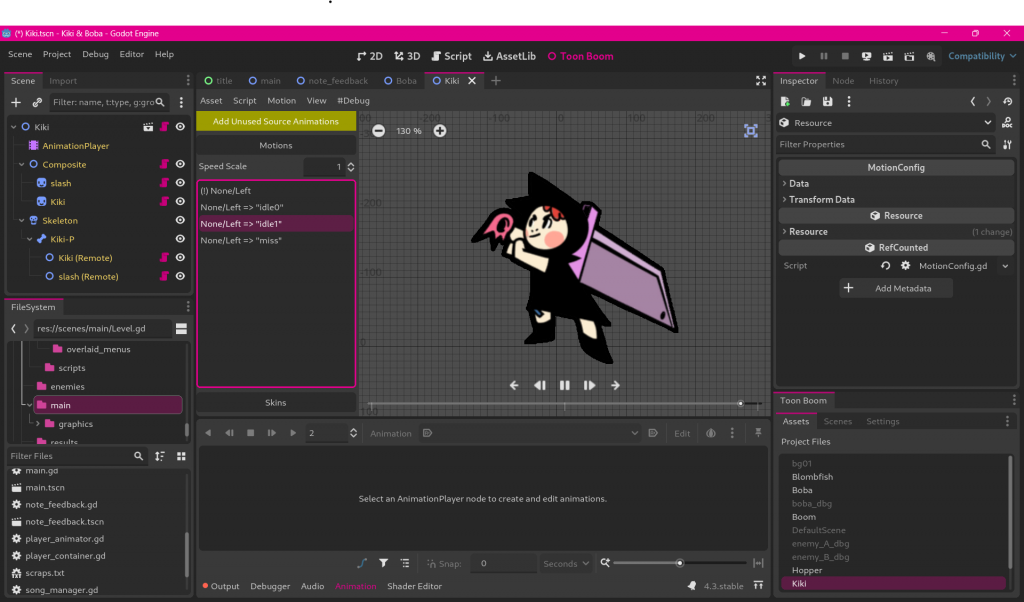
So what was the game jam like?
Landon: We had 12 days for the game jam. I had participated in jams before, so I knew that avoiding scope creep was a must! We decided to limit ourselves to two characters (plus Hopper), two enemies, 1 song, and 1 background.
The aim was to create a high-quality minimum viable product. Limiting the game to only the essential elements allowed us to make each one shine, leaving time to add polish and visual flair. Plus, we can always add to the game later.
Finn: I took a lot of cues from the Wii game Rhythm Heaven Fever. But we wanted to introduce something new. We had a lot of ideas, but the essential parts of the game had to be tackled first, so there’s some features we will add back later.
You used Jump!, which is Toon Boom’s beta software for game development to make Kiki & Boba. Could you share a bit about the process and pipeline for animating a game with Jump!
Landon: Jump! shares many of Harmony’s excellent drawing tools, so aside from some absent features, it was easy to adapt. Coming from a program like Flash would be a bit harder.
We all did storyboards on a collaborative canvas app called Magma, although I used the Jump! Storyboard Editor for a few sketches. In the Asset Editor, I was pleased that Jump! facilitated easy file handling by saving each asset as a single .tbg file. Unlike with Harmony, we didn’t need to zip them up before adding them to cloud storage.
So if my teammates did animation work on, say, Kiki or Boba, I could easily download the new file, place it in the game’s folder, then export it in the right resolution. From there, Jump! would automatically create a Godot Engine scene file that set up the characters’ animation data exactly how we defined it in the asset editor, which was incredibly helpful — easily my favorite feature!
I didn’t even have to worry about the character being cropped by the canvas frame; Jump handled that seamlessly even when characters were outside the bounds. Once the assets were imported as scenes, I could place them in the game and use code to control its playback.
Finn: It was also super useful to have a single file for each character that I could pull all frames into. They were all packed into there and didn’t need to be exported as individual images.
For game animation it’s mostly cycles you’re working. You need to be sure that it loops well, and seamlessly goes into other animations. It also has to swap into other cycles as well.
It’s a lot of working with the frames you have and making sure everything flows together and makes that satisfying motion. With a rhythm game you need the feedback immediately, otherwise it doesn’t feel right, it feels sluggish. You have to bridge the gap between having functioning animation and immediate feedback.
Vincent: I’m used to the animation pipeline, but I’m typically involved earlier in the pipeline. Working on Kiki & Boba was fun because I got to be part of the process the whole time. I was drawing assets right up until the end. Everyone was getting their input in all the way through. It was my first time using a program like Jump!, which was a learning experience. I got the hang of it pretty easily!
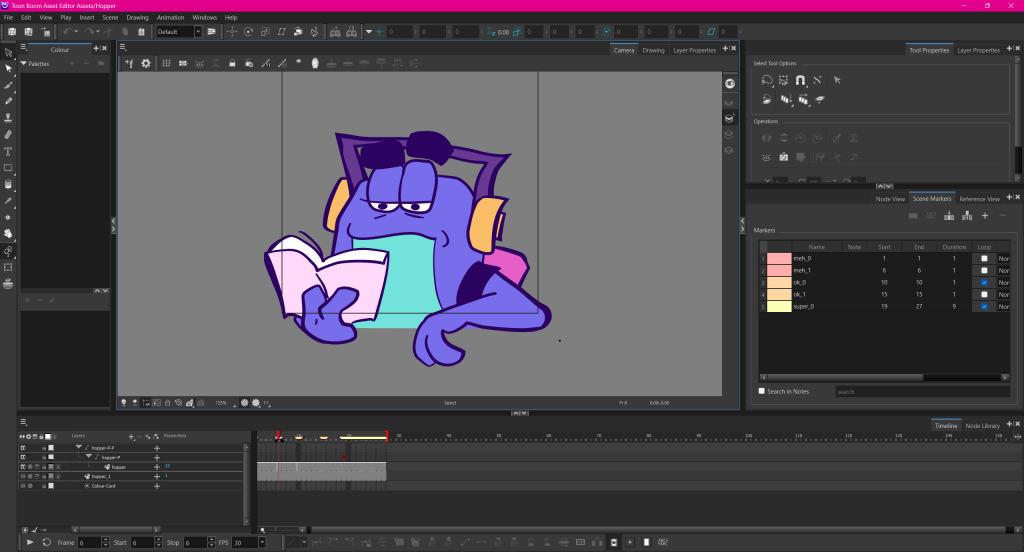
What was the most challenging part, from an animation or technical perspective, of creating Kiki & Boba, and how did you overcome it?
Vincent: The aesthetic of the game was very important to us. We had strong characters out of the gate, but we spent a lot of time refining the world that we built around them. We knew we needed UI, backgrounds, and characters, but then there’s all the sub-parts like fonts, how it’s laid out on the screen, the resolution, and how the background changes. It took a long time to land on the aesthetic vision.
Finn: Honestly, one of the most challenging parts was the colours. Kiki and Boba started as sketches in my sketchbook, so I had ideas of what I wanted the colours to be, but these ideas weren’t set in stone. When we started experimenting with different colours, we ran into issues.
For example, we figured out Boba’s colours and then put her against the background only to find that she melted into the background. We went back and forth so many times to figure out the colours. That was the toughest part of everything.
Landon: From a technical perspective, the hardest part for me was turning the sound data into an actual level, especially since this was such a crucial aspect of the game. I composed the music in a program called UltraBox, which can export as both MIDI and WAV file format. I used a plugin for importing MIDI files in Godot, but it didn’t work on the web platform.
There were a lot of problems with input lag too. While rhythm games are fairly easy to make, it’s much more difficult to make one that feels reliable and responsive. In early versions, the game wouldn’t compensate for audio latency, and if the game’s code lagged, the music would fall even further out of sync. I had to put in checks to compensate for lag and keep the music, enemies, and input code all synced up.
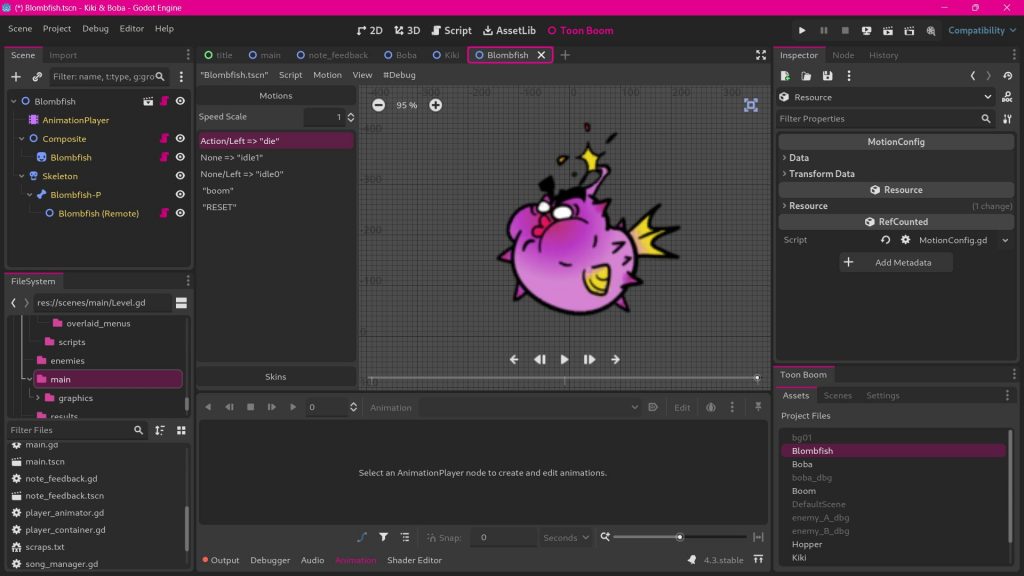
What has the reception of the game been like so far? Any plans to create more games in the future?
Vincent: I’ve really enjoyed reading the comments people are leaving about the game. It’s so fun to see how excited people are about it, and it’s created a really nice community feeling around the game. We also have really enjoyed checking out the other games that were made in the game jam, and we’ve built community with those creators, too.
Landon: We’re talking about creating a 2.0 version of Kiki & Boba, with new songs and other features. I loved making the music for the game so I’m excited to make more.
Finn: Also, Vincent and I have been working on a project called Gorp World. I can’t say much more, but stay tuned!
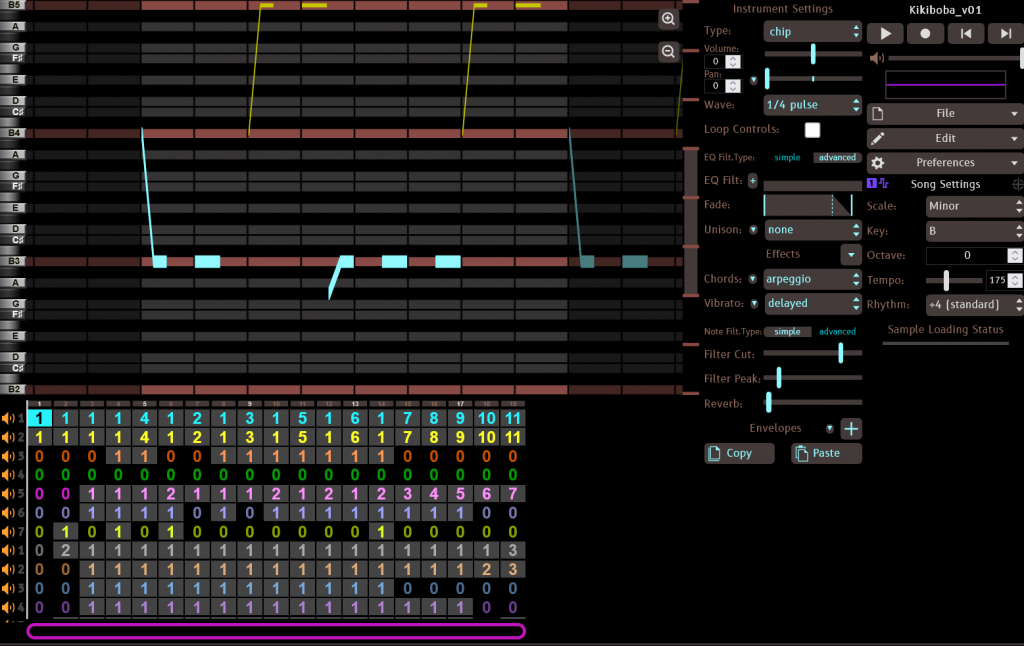
Before we wrap up, I need to ask! How did you land on the name “Kiki & Boba?”
Finn: This is a fun story! Kiki and Bouba was an exercise in universal shape theory. It’s a famous experiment where a person is shown two shapes: a spiky shape, and a rounded shape. The person is asked to name one of the shapes Kiki, and the other Bouba.
This experiment has found that across languages, genders, ages and more, 95% of people will assign the name Kiki to the spiky shape, and Bouba to the rounded shape. The character designs came first, and while mulling over names I had the realization that the two were very ‘kiki and bouba.’
After that, the names just stuck. ‘Bouba’ was changed to ‘Boba’ for clarity of pronunciation. Overall, I feel the name is very apt for a rhythm game. It highlights the interplay between visuals and sounds.
- Want to see more from the crew behind Kiki & Boba? Be sure to visit the portfolios for Landon X. Jenkins, Finn Kulers, and Vincent Tracy.
- Looking for more game prototypes developed with Jump!? You can find the complete list of Toon Boom Winter Game Jam entries on itch.io.
- Ready to get in on the fun? Artists and game designers can currently sign up for the open beta of Toon Boom Jump! and join the Toon Boom Spring Game Jam.


